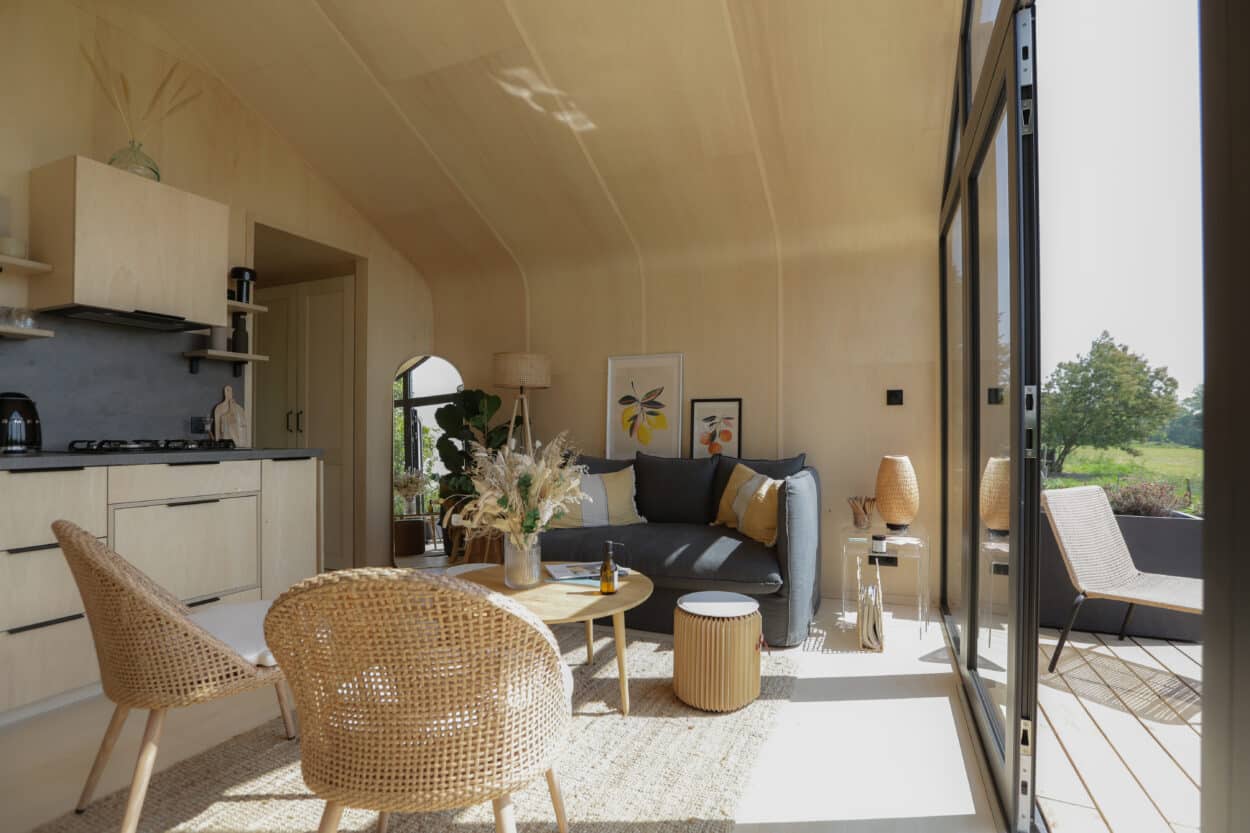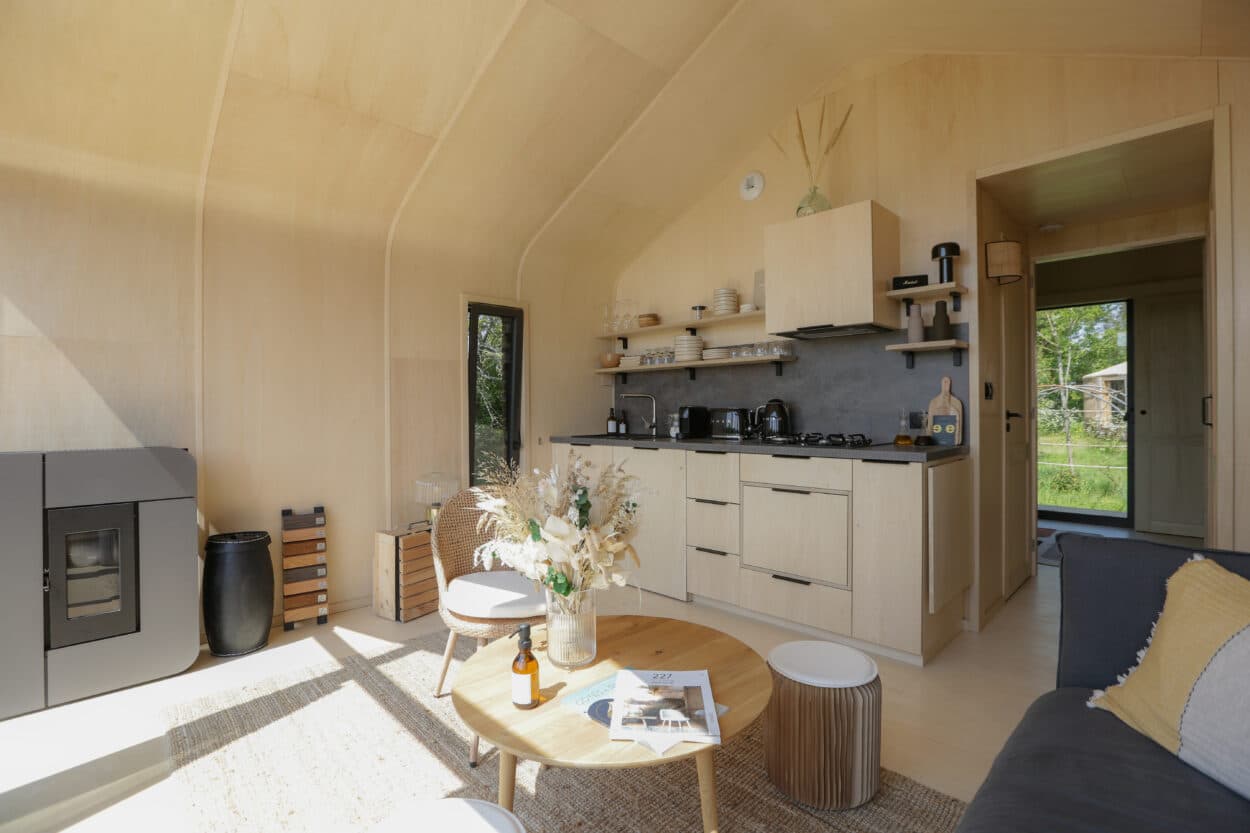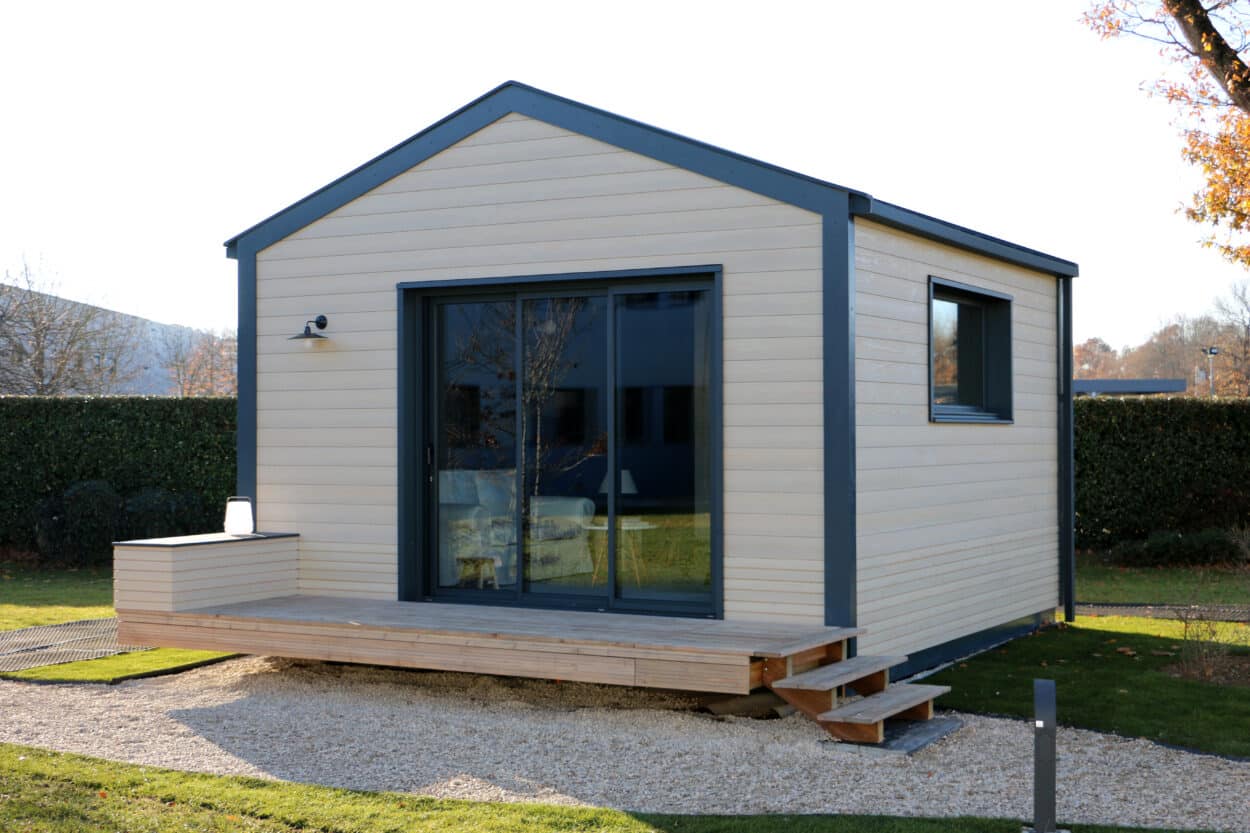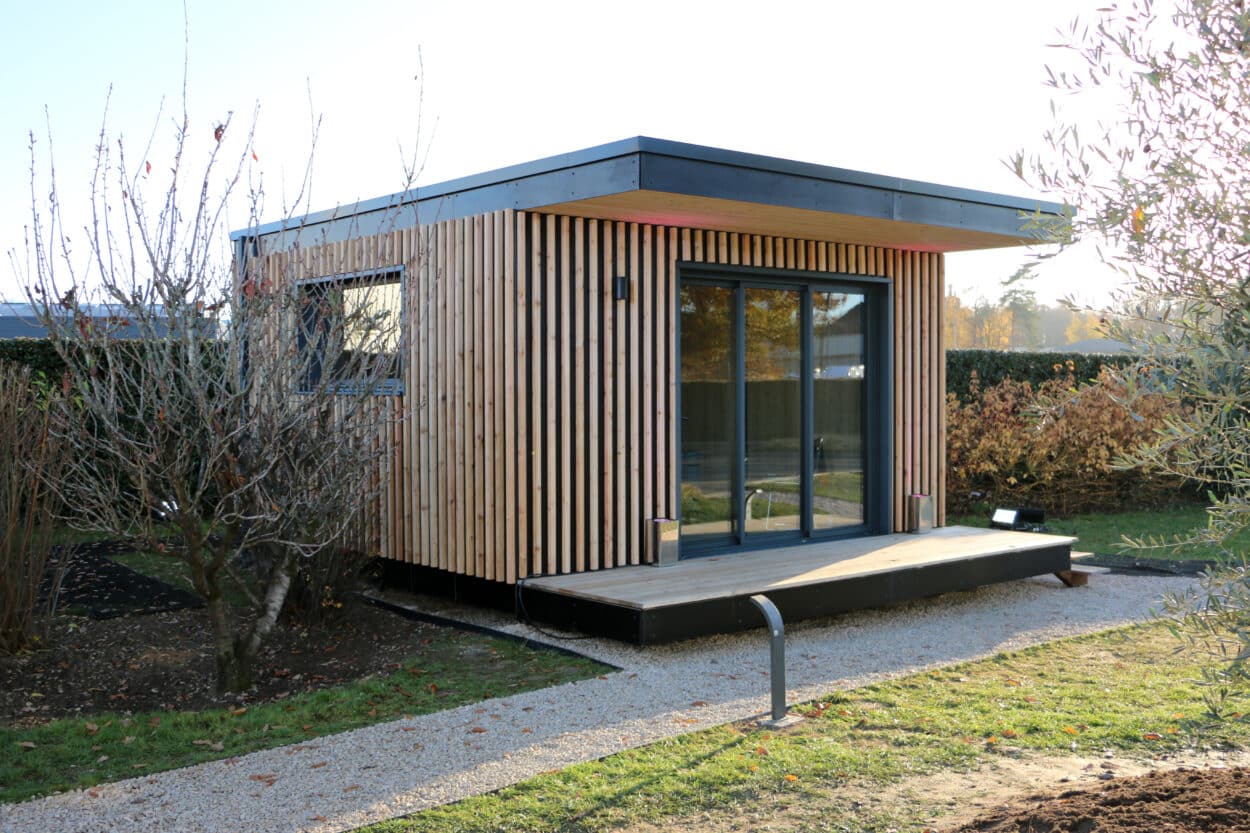A law that passed in 2014 opened the doorway to tiny houses in France, and the tiny house market has been surging ever since. **Courtesy of the individual brands for all images; the featured image: Les P’tits Nids.
Following the ongoing success of the Tiny House on Wheels (TOW) movement in the US, where the story began with Jay Shafer’s 90 ft² TOW, completed in 2000, the founder of La Maison Écologique magazine couldn’t resist taking a shot at it. In 2013, Yvan Saint-Jours constructed one of the first Tiny House on Wheels in France.
Although the American tiny house journey is considered to have started with philosopher Henry David Thoreau who secluded himself from the world in a very small house in 1854; it wasn’t until 1998 that regulations provided the opportunity for Shafer to legally ‘drive’ the trend. Similarly, Saint-Jours has been finding the right ways to have the TOW legally accepted in France. He hasn’t been alone, however, with other trend leaders pushing government officials to rethink the boundaries of housing legislation. One such advancement occurred in 2014 with the creation of a new law: Alur, offering judicial existence to “lightweight” habitats such as yurts, TOWs and tiny houses.
READ: Tiny House Cultures in Comparison – Germany, USA, Netherlands
The TOW expanded from its nomad model to a fixed version for supplementary or permanent living habitats. At first, the fixed tiny house came out of times of struggle—like in 2005 with Hurricane Katrina in New Orleans which generated a need for minimalist habitats for people undergoing serious situations. The financial crisis of 2008, in which many US Americans lost their homes, also contributed to the growing popularity of tiny houses. Later, the reason for selecting a tiny house transformed into a growing desire to return to nature, to reunite with our environment by connecting more with the exterior than the interior and to solve ecological problems by selecting a more sustainable lifestyle.
In France, over the last few years, the market for various tiny houses has also surged. In 2019, the country saw its first tiny house village, constructed in Brittany. Since the start of the trend, more and more entrepreneurs are launching small companies that manufacture such habitats, including Les P’tits Nids and LODJ.
READ: Middle East and Africa Tiny Homes Market – Industry Trends and Forecast to 2029

Les P’tit Nids: With You or Not at All
Twenty years ago, Cyrille Guerin participated in the construction of a passive house in Grenoble where, last year, construction began on the country’s first-ever passive building. His lifelong passion for eco-concepts, sustainability and wood houses trickled down to the next generation in his family, to his daughter Andréa. The father-daughter duo decided to join forces and develop tiny houses, leading them to found the company Les P’tits Nids in 2021.
Prior to launching Les P’tits Nids, while working on a personal project, they discovered the quality craftsmanship of the French company Guérin-Brémaud, which is classified as a SCOP (Société Coopérative et Participative); employees hold at least 51% of the share capital and 65% of the voting rights. They knew they wanted to work with Guérin-Brémaud on the construction of their tiny houses.
“SCOP is a rather particular kind of business where most of the employees own two and a half shares of the company. The implication and know-how are significant. For us, to bring our idea to life, it was with [Guérin-Brémaud] or not at all,” Andréa Guerin said in a phone interview with ArchiExpo e-Magazine.
Despite the increasing interest in tiny houses, with more people talking about it and news reports on the TV in France, those embarking on a tiny house project still confront resistance from certain members of town governments because as soon as they hear the term “a lightweight home”, they imagine a home fitting for a travel lifestyle.

“For many of them, the nomadic lifestyle is synonymous with “messy land”. It involves people who leave things on the land—a washing machine in the front lawn, for example.”
In order to combat the prejudice of preconceived notions, that the tiny house is a partially built home with missing blocks, they present architectural plans and renderings to the town officials who approve permits and explain how their homes respect nature and legislation.
“We designed our houses to be used as year-round principal residences so we worked on maximizing storage space and insulation. What we’ve been observing since we began commercializing our houses, though, is that we have more rental projects or extensions than principal residences. The rental projects include secondary homes and Airbnb houses, while extensions include office spaces and guest rooms.”

They have three models—the Pélican was released at the end of last year—and a customizable option, called Hibou Rouge (Red Owl). Although they’re open to new ideas in line with customer needs, they have to respect shipping restrictions and standards as 90% of the house is built in their factory, then shipped. The house can be fully delivered “key in hand” or partially constructed; it’s placed on a pile foundation. The signature of the P’tits Nids is the style of the roof and the structure which resembles a typical house but with rounded corners.
Last week, they evolved their designs to fit the latest thermal recommendations, going from RT 2012 to RT 2020.
Clean Construction: Dry Techniques and Metal Piles
A year prior to Les P’tits Nids, the family-run company thévenin founded its independent brand LODJ in 2020. The brand proposes small structures as solutions for multiple categories, such as renting, external offices or year-round living. The team behind LODJ had observed companies emerging in the tiny house sector over the past ten years, with a noticeable increase in the last five years. Since 2020, when Covid happened, the market drastically expanded.
CEO Nicolas Soucier recalled the advantages of the mobile tiny house (TOW) compared to its fixed counterpart. In terms of authorization, he mentioned, there aren’t any specific restrictions because they can be moved and placed anywhere.
“TOW corresponds to the ultra-free lifestyle: I live where I want, I stop where I want,” Nicolas Soucier said in an interview with ArchiExpo e-Magazine. “They’re often associated with new modes of autonomous living with solar panels, dry toilets and a rainwater harvesting system, for example.”

The team at thévinin, with 50 years of experience in the renovation industry, recognized growth in the TOW market in France but also in the market for fixed tiny houses over the last two or three years. In 2017, they conceived what they called the Maison thévenin which gave them experience working with wood panels. Finally, they developed the independent brand LODJ and began producing fixed tiny houses, known as ‘micro-maison’ in French.
Similar to Les P’tits Nids, LODJ tiny houses can vary in size, although the existing models are 20m² or 40m², and they are also placed on a metal pile foundation.
“Our houses don’t sit on a concrete foundation so in regards to the environmental impact, it’s the best solution. This type of foundation can function for 80 to 90% of the time; rocky soil does present a challenge so we use a concrete solution with smaller piles.”
The type of foundation is often a topic of importance as well as thermal insulation. It’s easy to wonder how well these small homes manage the passage, transfer and leakage of heat and electricity. In LODJ houses, they mainly employ stone wool insulation but have used wood wool insulation for certain projects.


Although LODJ focuses on turnkey contracts for which they deliver the materials on-site and manage the installation and assembly of the house; they offer an exception to those with experience and provide the house in a kit.
“The trend [for these small structures and tiny houses] already existed but Airbnb, when it came to France, accelerated the market. The average person could rent their guest bedroom or their entire apartment, generating a new avenue for revenue. Previously, it was reserved for professionals in the real estate sector [or hotel industry]. Now, the seasonal tendencies like student housing and additional space for personal use have become more and more sensical.”
Originally, the LODJ, like many tiny houses, could be used as an additional living space such as an office or a music studio; the brand first devised a 20m² model which doesn’t require a building permit, only a preliminary declaration of works to the town hall to obtain a planning permission. It’s easier and quicker. Yet, this size might not suit the needs of the majority of buyers looking for a tiny house as a principal living space outside of student living and guestrooms. They’ve since conceived a 40m², a better option for permanent housing. To respect the concept of the tiny house, they do not plan on exceeding 50m². LODJ has received B2C clients as well as B2B. Recently, they worked on B2B projects for hotels and golf course complexes.











